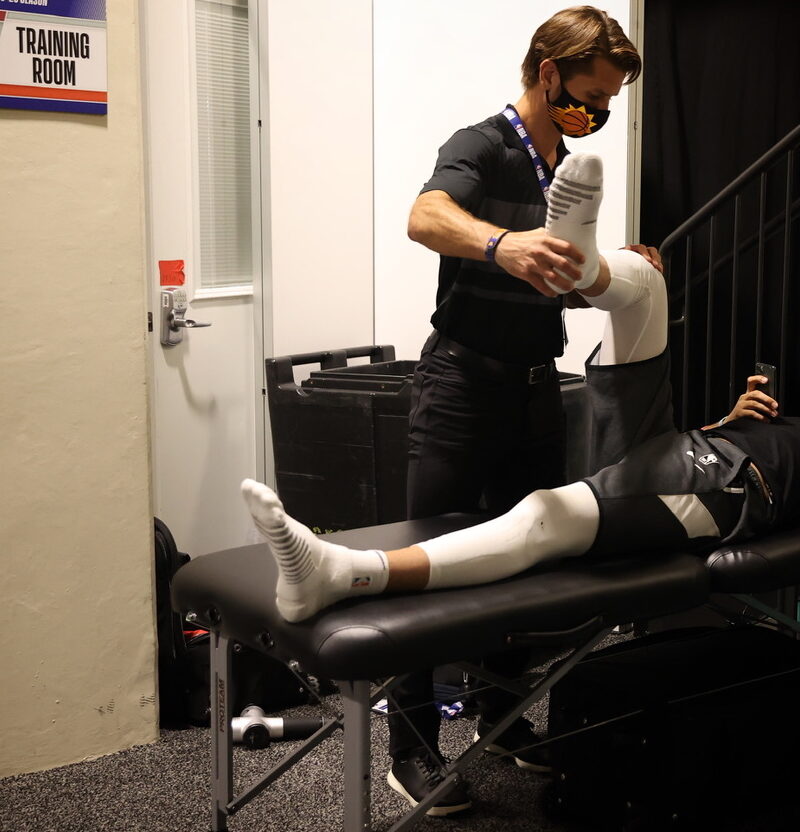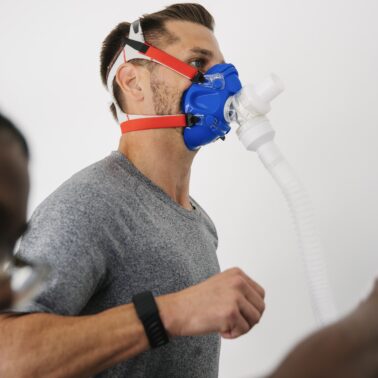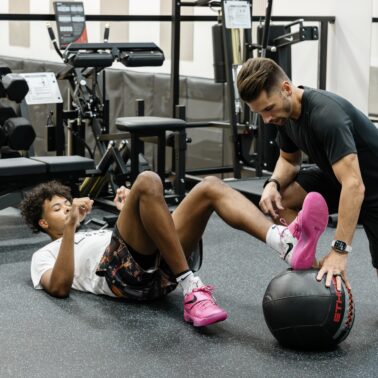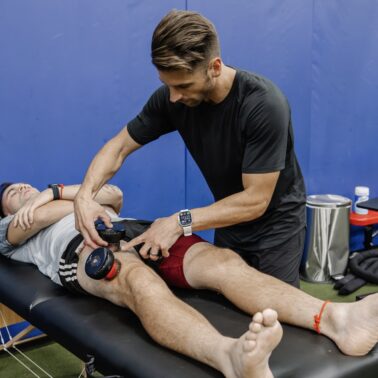“Compression + muscular contraction is my number one way to reduce swelling. Period.”
Adam Loiacono
What You Will Learn
- The physiology of swelling.
- Swelling as an indicator of progress & load during sports rehab.
- Strategies to manage and reduce swelling.
Your ankle is swollen – what do you do? Ice seems to be a common theme for most. In this article I talked about how we need to reconsider the use of ice for swelling.
If not ice, what is it? Over the counter medications are another common theme I hear people ask. There is evidence to suggest certain classes of NSAIDs can impede the healing process.
The (2) things that I believe are the best way to manage swelling are compression and movement. Both can come in various forms. But before we provide the solutions to swelling, we need to better understand what swelling is.
PHYSIOLOGY OF SWELLING
Swelling gets a bad reputation. I am not suggesting we want swelling, but we must ask the question why would the body have this response? The best resource to really understand pain and swelling is Explain Pain by David Butler. In summary, swelling is a massive inflow of chemical mediators, white blood cells, and accumulation of waste products. David Butler refers to this as “inflammatory soup.” The inflammatory soup is both beneficial and detrimental to the recovery of the injury.
When an injury happens, we want swelling. It is a necessary step to begin the healing process. The influx of white blood cells such as macrophages help eliminate damaged cells. The chemical mediators that flow to the injury site can help reduce pain. I am OK with swelling being present in an initial injury. The challenge with swelling is when it lingers it can create secondary limitations that are undesirable for rehab.
LOSS OF RANGE OF MOTION
Swelling impedes range of motion because fluid is incompressible. Think about if you were to fill up (2) large Ziploc bags with water. One bag is filled halfway and the other is filled to the max. The half-filled bag you will be able to fold, roll, and bend. The bag that is full can’t make too many shape changes and is rigid.
The Ziploc bag filled with half water is a normal joint. The Ziploc bag fully filled with water is a joint with swelling. A joint filled with fluid or surrounded with fluid in nearby pockets loses its ability to move through full ranges of motion. The swelling is simply filling the space that the joint would normally move through.
PAIN
The presence of swelling directly impacts the present of pain. The chemical mediators that are present within the inflammatory soup can produce increased sensitivity of the nervous system involved in the body that is injured. Hypersensitivity can therefore produce increases in pain or discomfort secondary to the presence of swelling.
Another way pain or discomfort is impacted by swelling is the overstimulation of mechanoreceptors. Mechanoreceptors are specific cells that produce outgoing neural signals to the brain from a specific tissue. The different types of mechanoreceptors are also specific to what type of stimulus produces a neural signal. Examples include light touch, deep pressure, and vibrations.
For example, when you have a rock in your shoe it can be quite uncomfortable. The reason for this is that a particular mechanoreceptor is being stimulated via pressure. That pressure stimulates the mechanoreceptor to send signals to the brain. Those signals are interpreted as being uncomfortable and you should probably get the rock out of your shoe.
The presence of swelling in a joint is like the rock in your shoe. Mechanoreceptors in and around the joint are being stimulated constantly letting your brain know that this is painful or uncomfortable. The challenge with swelling is it is not as easy to remove as taking a rock out of your shoe.
LOSS OF STRENGTH
Swelling to strength is the equivalent of kryptonite to Superman. Swelling makes us weak. From a high-level view, the presence of swelling reduces our strength secondary to reflexive pathways. Similar to how fatigue can reduce strength via neural pathways, a similar response exists when swelling is present.
The body is amazing at self-regulation. If something is present that the body does not like, then it will adapt by any means necessary to restore homeostasis. If swelling is present in a joint, then the body will self-regulate by inhibiting muscles not to contract and reduce movement in the joint.
Reducing swelling is always my priority with any injury or surgery. If we can reduce swelling then we can reduce pain, improve range of motion, and ultimately improve strength. As rehab progresses, swelling changes from being a limiter to rehab to being an indicator to rehab. The presence or lack of presence of swelling becomes a very important indicator for load management and speed of progressions in rehab.
SWELLING AS A PROGRESS INDICATOR
After we have an initial reduction in swelling from the acute injury, my perspective on swelling shifts. I transition from viewing swelling as a primary problem to swelling being a necessary adaptation. Why?
Anyone that goes to the gym and lifts weights has experienced swelling. The difference is you may not be aware of the swelling because it occurs intracellularly – inside the cells of your muscle. If the body naturally swells after loading body parts from weight training, then is it not reasonable to think that swelling would reoccur as we progress loading during rehab? Weight training is progressive overload. Rehab is progressive overload. I believe the underlying principle to be the same. Therefore, I do not fear swelling as rehab progresses. I expect it.
My general rule of thumb I have during rehab is progress (1) stimulus at a time and wait 24 hours. If the next goals in rehab are to improve jumping and sprinting abilities, then choose only (1) to progress in a single day.
The reason is I want to re-evaluate the injury 24 hours after the intervention has been provided to determine if the loading was appropriate. If the next day there are no changes in swelling, then the loading was appropriate. If I provide (2) different stimulus or interventions and the next day there is a change in swelling, then I do not know which intervention it was. That’s the premise of the scientific method. Create a hypothesis, provide an experiment to test your hypothesis, and then re-test your hypothesis. This concept of experiment is a key component of the 3P Framework.
TIPS, TRICKS, AND ADVICE ON SWELLING MANAGEMENT
COMMUNICATE EXPECTATIONS ABOUT SWELLING
Swelling, and pain, become my (2) key indicators when progressing rehab. I find it to be incredibly helpful to have the conversation about swelling with the athlete early on. We need to set reasonable expectations and help them understand that swelling will go up and down during rehab. It’s not necessarily a bad thing. It only becomes a bad thing when that swelling continues to be present. Then we may need to re-evaluate to determine if re-injury occured or another medical complication is at play here.
Another point to communicate to the athlete is that in the team sports setting we provide daily rehab. I have been in situations where after 3 days of rehab the athlete will come in with an increase in swelling even though Day 3 was less loading than Day 2. Chronic workloads can manifest as swelling just as much as acute workloads. Set those expectations to reduce fear or anxiety for the athlete when those situations occur.
COMPRESSION
I have a love-hate relationship with compression. I love it because after compression is removed there is an immediate reduction in swelling. We see immediate changes in pain free movements and ranges of motion. Whether that may be a compression stocking, NormaTec, or GameReady – they get the job done at reducing swelling. Unfortunately, there is often a rebound effect and the swelling returns rather quickly.
Let’s go back to the analogy of a Ziploc bag filled halfway with water. If I were to squeeze one end of the bag, then the water would push to the other end of the bag. As soon as I let go of the bag, then the fluid will come back to the area of I was just squeezing. Same thing happens with static compression of a joint. Where compression can become powerful in reducing swelling is when it is combined with muscular contraction or movement.
MOVEMENT
Movement is medicine is an incredibly undervalued phrase, and it applies directly to our situations of managing swelling. Our lymphatic and venous systems are embedded in muscles and surrounded by muscles. The contraction and relaxation of muscles helps literally push fluid through the 1-way valves of veins and lymph.
The muscles are our best strategy at helping eliminate swelling by pumping the fluid away from the injured area. Movement requires muscle contraction. Therefore, movement will help move fluid and ultimately reduce swelling.
BEST WAY TO REDUCE SWELLING
Compression + muscular contraction is my number one way to reduce swelling. Sometimes we can use movement to stimulate muscle contraction and help push fluid out. If I have a swollen knee or ankle, then I will place a compression stocking over the joint as the athlete pedals on a bike.
Pool walking is another great way to combine compression and movement with the added benefits of decreases in body weight. The presence of water changes the hydrostatic pressure of cells and can facilitate the clearance of swelling in combination with muscular contraction. Decreases in body weight will ultimately reduce the load and stress through the tissue. These decreases may be needed depending on the particular phase of rehab.
In instances when movement or loading is contraindicated, then modalities become my top choice. I prefer to use some form of neuromuscular electrical stimulation (NMES) in combination with a compression unit. My favorite combo is a MarcPro + a GameReady. The MarcPro provides a constant muscle contraction for hours while the GameReady provide cycling compression.
If pain is present, then I may defer to ice and water in the GameReady to use the cold aspect to manage pain. If swelling is present in the absence of pain, then I prefer to use room temperature water. The reason for this is decreases in tissue temperature change the fluid dynamics of the tissue and could potentially impede the tissue’s ability to reduce swelling.
Have questions on swelling? Leave a comment or connect over social media!



